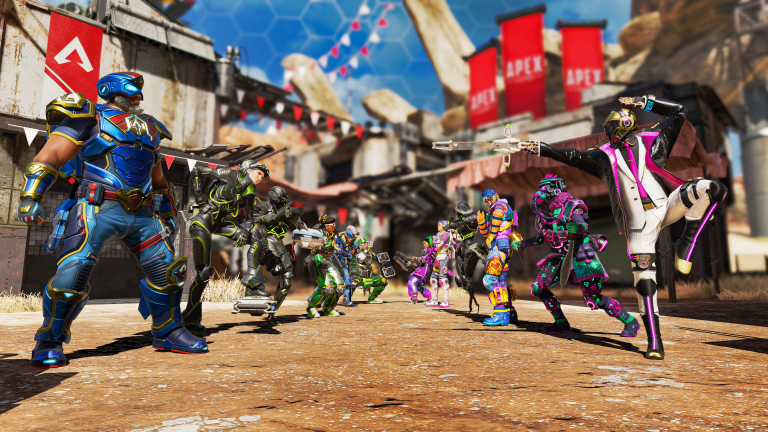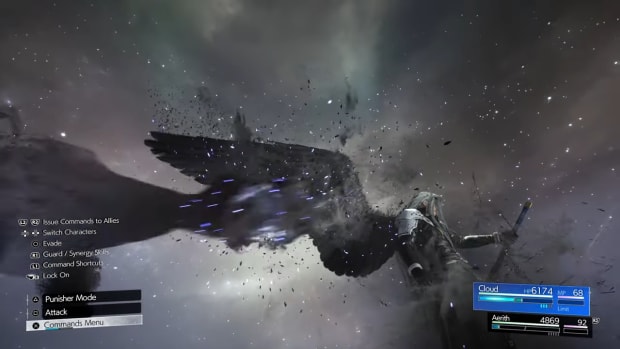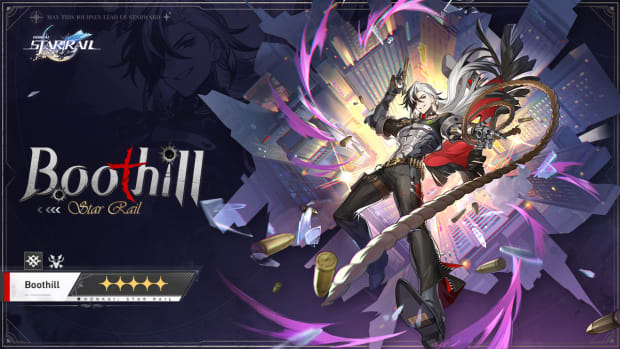
Apex Legends Season 16 interview: noise pollution, class changes, map learnings, and scan meta

Apex Legends Season 16 lands on February 14, 2023, celebrating four years of Respawn’s battle royale shooter with a range of meaty updates. Among them, there are five new classes, significant changes to seven Legends, a fresh assault rifle, and even a new game mode.
If you want to dive into all the Legend and class changes in Apex Legends Season 16, check out our dedicated article on that.
We spoke to the team at Respawn about the game’s health and how the new update will impact the way everyone plays.
GLHF: One of the big things from this update is your attempt to address the scan meta. How do the new changes affect it holistically?
Senior character designer Devan McGuire: The stab that we’re taking at it is trying to reduce the overall frequency of how scans will be affecting the game. So like the hit on Bloodhound with the removal of the instant refresh and the constant scans, I think, even before the rise of Seer, we saw a lot of games that were resulting in an Ult cast by Bloodhound and then scan after scan after scan, keeping constant knowledge of the game.
Once Seer came into the rise, Bloodhound simmered away a little bit, but any changes that we made on the back end to Seer just brought Bloodhound right back up. So we needed to make a holistic change to both of them to try and cap those down. So that’s the change we wanted to implement with the Bloodhound to put focus on the Passive and the tracking fantasy overtop of the scan. You still have access to scans, but they’re not as prevalent.
And then, similarly with Seer, we were finding the Ult was up, like every encounter that you were in, you had your Ult ready to go. And it lasted for pretty much the entire encounter. So those two big hits to the Ults were pretty simple and easy changes that we want to make just to keep it in a little bit more of a lesser cadence. And then a lot of the comments and feedback and a lot of things we were feeling revolved around the Passive and the free information that you get from just like, you know, clicking your mouse or hitting ADS and getting immediate knowledge of anyone that’s around you, or in a building beside you without them knowing that you were even there. So a lot of the changes that we pushed on those were meant to say, ‘Okay, you got to kind of commit to pull out your heartbeat sensor, if you want to get that information, which means you’re going to be waiting a little bit before it comes up, you got to wait for that animation and commit to it’.
We wanted it to be actually relevant to the heartbeat – that’s the whole point of the beat is kind of giving you the impression. What you could get before is, the moment you started activating that, it didn’t matter that the pulses were going off, you could maintain that lock on that yellow circle the entire time, like they’re kind of in your frustum, you’re gonna see that they’re there, they step out of it, it’s blue, it still maintains that thing. So you only get that information on that beat cadence, which makes it a commitment to actually getting that out. And that commitment is coupled with this idea that audibly now, you’re going to be heard by enemy players, and you’re gonna be able to suss out where you are. So that if you’re seriously committing, and you’re making that commitment to finding out where people are, they’re going to have the time to react and go, ‘I’m hearing a Seer. There’s a Seer over there. We could get scanned from that direction.’
So that in itself puts this risk and reward into Seer’s gameplay, which hopefully will pull back on the frequency of how often you’re getting heartbeat scanned and making that a more tactical decision, rather than just a free action that you do all the time.
GLHF: Did you see any data that showed Catalyst impacting the scans because obviously, her Ult is quite useful against them?
McGuire: It was part of the notion of what her Ult was meant to do. In terms of specific data that really resonated with that, we’re not seeing that hit on a grand scale right now, and we’re still continuing to look at what Catalyst brings to the table and whether or not that’s an area you want to go because her main focus is, you know, blocking visuals so you can make a rotation or a play that obfuscates from teams. And we’re looking at how the players are reacting to that particular data in order to make any adjustments in Catalyst. I think it is helping, but we’re not seeing a lot of Catalyst in more high-end comps. Occasionally when it is, it makes a difference; it’s really good at endzones. But I think as we progress to the next season, we’ll get more of that data. She’s only been out for a season, and we will make additional changes there if we see the need for it.
GLHF: Okay, cool. I’ve got a map question next. I really love Broken Moon, I was just wondering what lessons you’ve learned from that map that you might implement in the future?
Lead level designer Jeff Shaw: We learned quite a bit. We’ve learned about using larger POIs. We had some speculations when we launched that map that larger POIs would play a certain way once they got into the live environment. So we learned a lot more about controlling larger POIs, how teams can control larger POIs, how teams can kind of fight over the material, and the loot, and own the area. So, we’ve really thought about that approach, as a team – whether we want to continue using really large ones or not. So it’s something that we’re definitely thinking about. The other learning that we had was zip rails – how fast are they? How loud are they? Those are things that we might continue to tweak or play with in the future.
GLHF: But zip rails are so good.
Shaw: Oh, we love them. They clicked, you know, it’s like a roller coaster. It fits with the movement.
GLHF: It speeds everything up as well. You get between fights much quicker.
Shaw: Oh, yeah. We’re definitely just thinking about balancing the cadence of how often zip rails are present. Because a lot of time, if there’s a zip rail in your face, you’re pretty likely to use it. And so we really have to think about, you know, is this the best outcome? Do we really want people to gravitate toward zip rails here? So we’re really thinking about what we’re going to do and future changes that map,
GLHF: Do you think that you’ll add zip rails to other maps at some point?
Shaw: You know, never say never, but at the moment, they’re just exclusive to Broken Moon.
GLHF: What have you learned from Catalyst going live last season?
McGuire: one is how much people appreciate, and can reliably use something that impacts their door play. That was a thing in our play tests that kind of felt like it’d work. And if people can get used to the semi-awkward interaction, it’ll make sense. But it jived with the community, it hit hard, people were finding really good use cases – blocking passageways and preventing pushes, and that was really cool.
The other thing, which kind of speaks to the thing we were talking about just a few seconds ago, was what players’ expectations were around the impact of what scans did with the wall.
We were going off this theory – she’s giving you vision-blocking rotational abilities, coming out of her Ultimate. And yeah, it’s going to prevent scans and stuff from seeing you as a result. Before we added it, you could have Vantage aiming down the scope, and just following you the whole way along the line. And we were like, ‘Oh, we don’t want that.’ That’s the whole point of the ability, we want to prevent that from happening.
So we took an approach of, the source of the power, when it comes through, will not allow you to do that. But what in our minds was viable at the time is not the perception that the community had. They thought, ‘Hey, once the scan is active, no scan information is passing through that wall.’ And that disconnect was something that we didn’t really pick up on as being huge until it went live, and people’s perception outweighed the viability of it. I think people have understood and gotten around it over time, but it is something that we definitely learned from that experience, and we want to take into further evaluations of Catalyst moving forward.
GLHF: That makes sense. So you’ve added all these new classes this season. Now I’ve got a group of four friends, and there’s always someone fighting for that third spot, so are there any plans for larger team size mode in BR?
Senior design director Evan Nikolich: A larger team size BR? I mean, we haven’t put the time investment in to investigate that, but I would never say never. But right now, it’s not in our current plans.
GLHF. That’s fair. It just felt like three-person teams were because of the previous classes, and now you have five. I’ll keep my fingers crossed.
Nikolich: Yeah, we’ve put most of our effort this past year into revitalizing our current systems, the Legends in the weapons, and the maps. We’ll come back to delivering Legends next season and more standard fare. But yeah, we’re always looking into the next big evolution we can bring to Apex.
GLHF: Well, I appreciate the update cadence, and I hope you’ll get a rest soon as well. So the next question is something that comes up in the community a fair bit: noise pollution. Are there any plans to address that? Because sometimes footstep sounds are inconsistent.
Nikolich: I mean, we’re definitely investigating it. The tech is… our engine tech was not built with BR in mind.
GLHF: It’s Source Engine, right?
Nikolich: It is Source Engine-based, but it’s very modified from Titanfall. Forked long ago from Valve’s Source Engine. So it’s definitely something that bothers us personally, as well, we’re always trying to work on it and figure out ways to help improve the footsteps. So while we don’t have a direct fix this season, and I’m not sure we’ll ever be like a silver bullet fix, this is something we’re constantly working on season over season.
GLHF: What about Arenas? Did you close that down because not enough people were playing?
Nikolich: No, it was mainly focused around it’s not hitting the goals what we want it to be, what we want to serve in a more lower-stakes mode. There’s a lot of overlap and competition between the BR and Arenas in terms of the experience. What we really want is a mode that people can get in, warm up, practice, bring the stakes of death down, and be more inviting to get reps in on the game.
There’s a huge skill curve in Apex, which makes it a great game to play and keeps it super compelling, but it’s very hard and can be punishing. I’m getting a gun for the first time, I don’t know how it works, and I’m dead and then I’m out. In BR I’m out for the match, and then in Arenas, I’m out for X number of seconds or minutes. So it’s just not hitting that vibe that we want.
We want to bring in Mixtape and Team Deathmatch to hit more of that goal to be more relaxed, a bit more focused on just core fundamental gameplay, and let players get as many reps in as they want.
GLHF: Is that the same kind of ethos beyond the craftable banners as well, because that’s another chance for people to get back in the game, right?
McGuire: Yeah, it’s definitely one of them. We didn’t want to make it this ubiquitous thing across the whole game, or it would take away from that inherently strong gameplay around the fighting for a death box that you’ve lost a teammate to. We don’t want to take that out of the game, it’s a really core part of that loop. And it keeps people engaged, keep people from being like, ‘I’m done, I’m running from this fight’. But we did like the idea that it would be nice to get your friend back into the game if something bad happened – especially if they expired and they’re just sitting there waiting for you to come back. And if we have that onto a class role, then it feels like you’re actually focused on that aspect of the game and that aspect of keeping your team alive, you can have this extra play that you can strategize around, rather than taking it and making it just this part of the game that is now there for everybody. It’s now a focus, if you are that class role.
GLHF: We’ve still got to rely on the randoms not leaving the game as soon as they grey out.
McGuire: In Pubs, it’s going to be hard to convince someone not to want to just press the reset button and go. I think this change will strongly impact when you’re playing with your friends – people you’re going to start a new game with anyway. Or when you’re playing with your squad, your premade squad in Ranked, or you want to get those Ranked Points, the ability to keep yourself alive, that will be the incentive to keep you going.
I’m not going to be able to change a Wraith sweat from dropping my game and starting a new one or trying to get more kills. That’s not our goal. Our goal is to encourage better tactical and better overall strategic decision-making; it will help you win the BR.
GLHF: Last question because I’ve got two minutes left. But what kind of things have you seen from the playtests around this season? What differences have you seen with how people engage with the game?
McGuire: In terms of how they play with the classes?
GLHF: Yeah, like, how does it impact the overall feel – are there more battles, more players at the endzone, that kind of thing?
McGuire: Oh, that’s a good question. I mean, we have varying degrees of playtests. So it’s hard to say that it’s going to be representative of what’s in the actual game. But from what we’ve seen from the use cases, I’ll cite a couple of examples.
Having Recon characters scan beacons to find out where enemies are, that that’s a huge thing in terms of allowing the team to scout ahead and be like, ‘Oh, there’s a pocket we can rotate to here that safe’, and people are making decisions to do that. Or there’s an isolated team there, let’s dump on them because there’s no one else around that’s going to come in and third-party us, we can actually make that call happen.
And then vice versa. A thing that has happened a lot in play test is you’ve been kind of nearby, looting around, somebody uses a beacon, and now you’re aware that they’re over there looking at you, and you’re ready to take that fight back or to ambush them and counter assault. The Recon one has actually been a huge change in our playtests in terms of that kind of front.
There are a few other examples I can cite of people like, ‘Oh, there’s an income a care package. Can you spot that for us? Let’s see if you want to make a play for that. Yeah, that’s a Kraber; let’s go get that Kraber because we’re close enough, we can make that call and go grab it and then have the advantage moving in from the edge’. Lots of cool things have systematically developed. Again, our playtests are not exactly representative of when servers are live, so we’re really excited to see what happens when it goes live.
If you're an Apex Legends esports fan, here's a breakdown of TSM's road to victory in the Apex Legends Global Series: Split 1 Playoffs.






